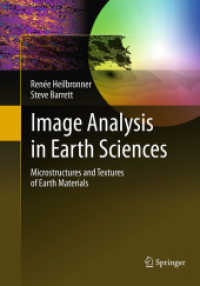- ホーム
- > 洋書
- > ドイツ書
- > Mathematics, Sciences & Technology
- > Biology
- > botanics
Description
(Text)
Sphagnum specialist Dierk Michaelis documents the worldwide known peat moss species (genus Sphagnum) and presents keys for their identification. It represents the updated, supplemented English language version of the author's original peat moss flora of 2011 (in German), the first overall presentation of Sphagnum since Carl Warnstorf's "Sphagnologia Universalis" of 1911. Compared to the German edition, 12 species have been added, 23 new plates were added, the chapters on phylogeny and research history have been revised and a new chapter on Sphagnum ecology has been added. Since Warnstorf's comprehensive work, numerous names have been recognized and revised as synonyms - particularly by Andrews, Eddy and Isoviita. These revisions, and the approximately 150 new species described since then, have been incorporated into this volume, as well as the results of the author's own studies. Genetic characteristics were used to define the species of problematic groups. The peat mosses are ofkey ecological and economic importance among the mosses. They populate almost all continents with a clear focus on northern South America, North America, East and North Asia and Europe. The genus Sphagnum is very isolated within the Bryopsida, similarities in the construction of the sporophyte indicate a distant relation to the rockmosses (class Andreaeopsida). For the internal classification of Sphagnum there are very different approaches with up to 4 subgenera and up to 18 possible sections, of which 14 are distinguished in this volume. Peat mosses in the narrow sense (genus Sphagnum) feature a combination of leaf dimorphism (stem and branch leaves), cell dimorphism (living chlorophyll and empty hyaline cells) and branch dimorphism (strongly assimilating spreading branches and hanging branches serving the outer water supply) that is unique among mosses. Although the assignment of any peat moss to the genus Sphagnum usually does not cause any problems, the determination down to the species level causes difficulties sometimes. The author introduces and describes the anatomy and morphology of Sphagnum, and explains the reproductive biology, the research history and phylogenesis of peat mosses. The systematic part is divided into three segments: Description and identification of the sections, keys for all peat moss species, separated by continents, as well as Sphagnum species lists for 20 phytogeographic regions of the world. The keys for Africa, Europe and North America are based on existing data and were revised and supplemented with the help of recent descriptions, updated species concepts and new floristic data. Completely new keys have been developed for South America and Asia, as these did not exist pr1eviously. 292 peat moss species are described in detail, supplemented by data on habitats, geographical distribution and lists of synonyms. This section is supplemented by the presentation of the inner and outer characteristics on 219 plates. A very extensive bibliography rounds off the volume.








